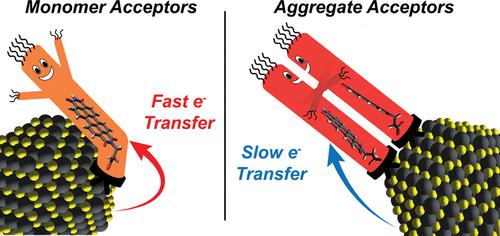当前位置:
X-MOL 学术
›
J. Am. Chem. Soc.
›
论文详情
Our official English website, www.x-mol.net, welcomes your
feedback! (Note: you will need to create a separate account there.)
Aggregation of Charge Acceptors on Nanocrystal Surfaces Alters Rates of Photoinduced Electron Transfer
Journal of the American Chemical Society ( IF 14.4 ) Pub Date : 2022-11-30 , DOI: 10.1021/jacs.2c09758 Danielle M Cadena 1, 2 , Jakub K Sowa 2, 3 , Daniel E Cotton 1 , Christopher D Wight 1 , Cole L Hoffman 1 , Holden R Wagner 1 , Jessica T Boette 1 , Emily K Raulerson 1 , Brent L Iverson 1 , Peter J Rossky 2, 3 , Sean T Roberts 1, 2
Journal of the American Chemical Society ( IF 14.4 ) Pub Date : 2022-11-30 , DOI: 10.1021/jacs.2c09758 Danielle M Cadena 1, 2 , Jakub K Sowa 2, 3 , Daniel E Cotton 1 , Christopher D Wight 1 , Cole L Hoffman 1 , Holden R Wagner 1 , Jessica T Boette 1 , Emily K Raulerson 1 , Brent L Iverson 1 , Peter J Rossky 2, 3 , Sean T Roberts 1, 2
Affiliation

|
Semiconductor nanocrystals (NCs) interfaced with molecular ligands that function as charge and energy acceptors are an emerging platform for the design of light-harvesting, photon-upconverting, and photocatalytic materials. However, NC systems explored for these applications often feature high concentrations of bound acceptor ligands, which can lead to ligand–ligand interactions that may alter each system’s ability to undergo charge and energy transfer. Here, we demonstrate that aggregation of acceptor ligands impacts the rate of photoinduced NC-to-ligand charge transfer between lead(II) sulfide (PbS) NCs and perylenediimide (PDI) electron acceptors. As the concentration of PDI acceptors is increased, we find the average electron transfer rate from PbS to PDI ligands decreases by nearly an order of magnitude. The electron transfer rate slowdown with increasing PDI concentration correlates strongly with the appearance of PDI aggregates in steady-state absorption spectra. Electronic structure calculations and molecular dynamics (MD) simulations suggest PDI aggregation slows the rate of electron transfer by reducing orbital overlap between PbS charge donors and PDI charge acceptors. While we find aggregation slows electron transfer in this system, the computational models we employ predict ligand aggregation could also be used to speed electron transfer by producing delocalized states that exhibit improved NC-molecule electronic coupling and energy alignment with NC conduction band states. Our results demonstrate that ligand aggregation can alter rates of photoinduced electron transfer between NCs and organic acceptor ligands and should be considered when designing hybrid NC:molecule systems for charge separation.
中文翻译:

电荷受体在纳米晶体表面的聚集改变了光生电子转移的速率
半导体纳米晶体 (NC) 与充当电荷和能量受体的分子配体连接,是用于设计光捕获、光子上转换和光催化材料的新兴平台。然而,为这些应用探索的 NC 系统通常具有高浓度的结合受体配体,这可能导致配体-配体相互作用,从而可能改变每个系统进行电荷和能量转移的能力。在这里,我们证明受体配体的聚集会影响硫化铅 (II) NCs 和苝二亚胺 (PDI) 电子受体之间光致 NC 到配体的电荷转移速率。随着 PDI 受体浓度的增加,我们发现从 PbS 到 PDI 配体的平均电子转移速率降低了近一个数量级。随着 PDI 浓度的增加,电子转移速率减慢与 PDI 聚集体在稳态吸收光谱中的出现密切相关。电子结构计算和分子动力学 (MD) 模拟表明 PDI 聚集通过减少 PbS 电荷供体和 PDI 电荷受体之间的轨道重叠来减慢电子转移速率。虽然我们发现聚集减慢了该系统中的电子转移,但我们采用的计算模型预测配体聚集也可用于通过产生离域状态来加速电子转移,这些离域状态表现出改进的 NC 分子电子耦合和与 NC 导带状态的能量对齐。
更新日期:2022-11-30
中文翻译:

电荷受体在纳米晶体表面的聚集改变了光生电子转移的速率
半导体纳米晶体 (NC) 与充当电荷和能量受体的分子配体连接,是用于设计光捕获、光子上转换和光催化材料的新兴平台。然而,为这些应用探索的 NC 系统通常具有高浓度的结合受体配体,这可能导致配体-配体相互作用,从而可能改变每个系统进行电荷和能量转移的能力。在这里,我们证明受体配体的聚集会影响硫化铅 (II) NCs 和苝二亚胺 (PDI) 电子受体之间光致 NC 到配体的电荷转移速率。随着 PDI 受体浓度的增加,我们发现从 PbS 到 PDI 配体的平均电子转移速率降低了近一个数量级。随着 PDI 浓度的增加,电子转移速率减慢与 PDI 聚集体在稳态吸收光谱中的出现密切相关。电子结构计算和分子动力学 (MD) 模拟表明 PDI 聚集通过减少 PbS 电荷供体和 PDI 电荷受体之间的轨道重叠来减慢电子转移速率。虽然我们发现聚集减慢了该系统中的电子转移,但我们采用的计算模型预测配体聚集也可用于通过产生离域状态来加速电子转移,这些离域状态表现出改进的 NC 分子电子耦合和与 NC 导带状态的能量对齐。











































 京公网安备 11010802027423号
京公网安备 11010802027423号